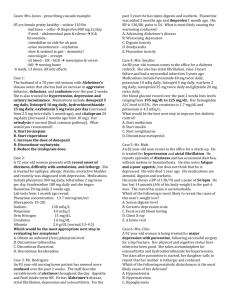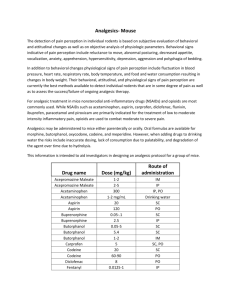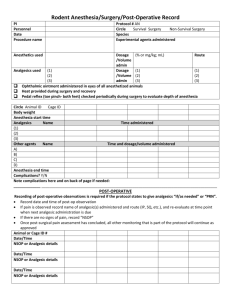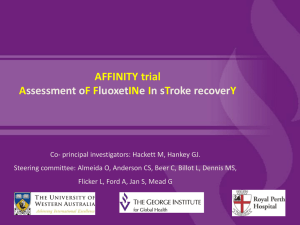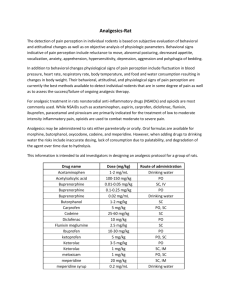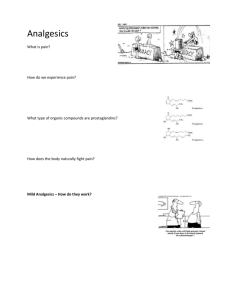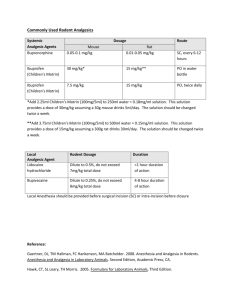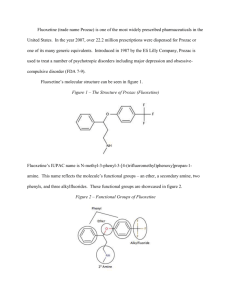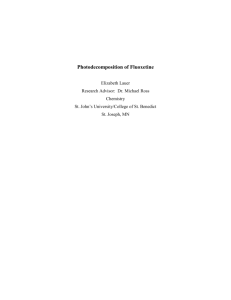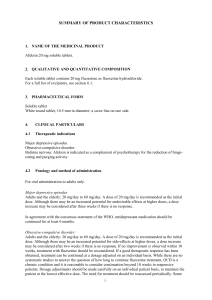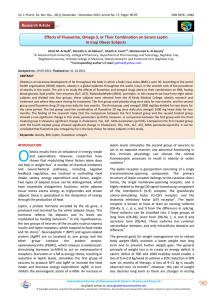A Comparative Study of Analgesic Activity of Fluoxetine with
advertisement
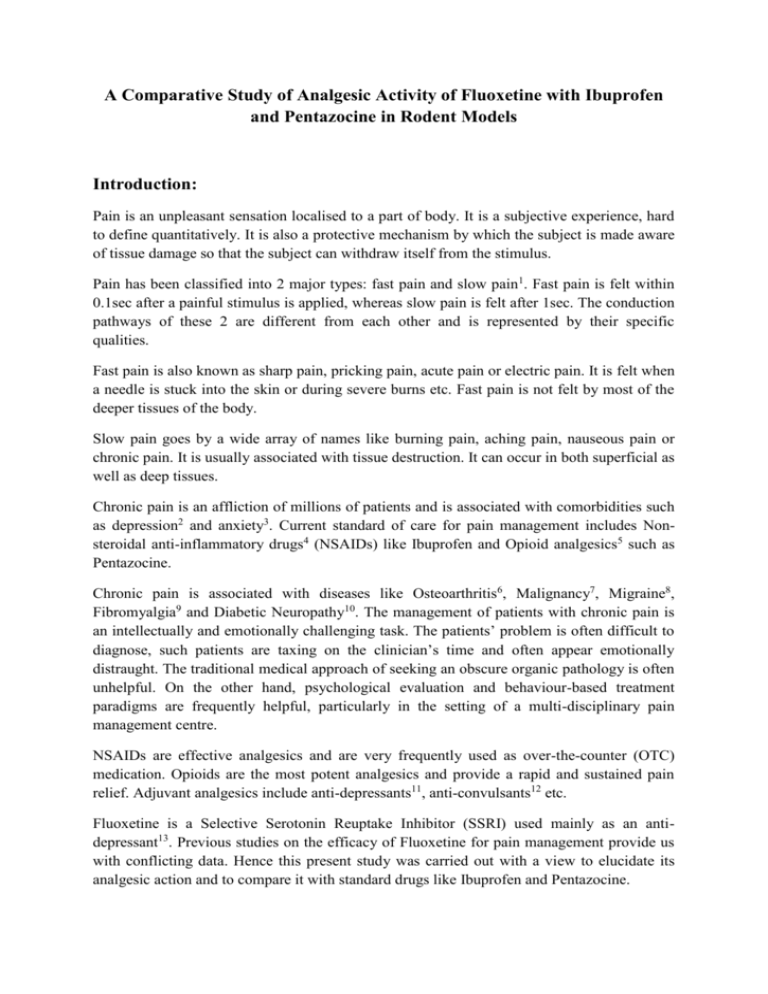
A Comparative Study of Analgesic Activity of Fluoxetine with Ibuprofen and Pentazocine in Rodent Models Introduction: Pain is an unpleasant sensation localised to a part of body. It is a subjective experience, hard to define quantitatively. It is also a protective mechanism by which the subject is made aware of tissue damage so that the subject can withdraw itself from the stimulus. Pain has been classified into 2 major types: fast pain and slow pain1. Fast pain is felt within 0.1sec after a painful stimulus is applied, whereas slow pain is felt after 1sec. The conduction pathways of these 2 are different from each other and is represented by their specific qualities. Fast pain is also known as sharp pain, pricking pain, acute pain or electric pain. It is felt when a needle is stuck into the skin or during severe burns etc. Fast pain is not felt by most of the deeper tissues of the body. Slow pain goes by a wide array of names like burning pain, aching pain, nauseous pain or chronic pain. It is usually associated with tissue destruction. It can occur in both superficial as well as deep tissues. Chronic pain is an affliction of millions of patients and is associated with comorbidities such as depression2 and anxiety3. Current standard of care for pain management includes Nonsteroidal anti-inflammatory drugs4 (NSAIDs) like Ibuprofen and Opioid analgesics5 such as Pentazocine. Chronic pain is associated with diseases like Osteoarthritis6, Malignancy7, Migraine8, Fibromyalgia9 and Diabetic Neuropathy10. The management of patients with chronic pain is an intellectually and emotionally challenging task. The patients’ problem is often difficult to diagnose, such patients are taxing on the clinician’s time and often appear emotionally distraught. The traditional medical approach of seeking an obscure organic pathology is often unhelpful. On the other hand, psychological evaluation and behaviour-based treatment paradigms are frequently helpful, particularly in the setting of a multi-disciplinary pain management centre. NSAIDs are effective analgesics and are very frequently used as over-the-counter (OTC) medication. Opioids are the most potent analgesics and provide a rapid and sustained pain relief. Adjuvant analgesics include anti-depressants11, anti-convulsants12 etc. Fluoxetine is a Selective Serotonin Reuptake Inhibitor (SSRI) used mainly as an antidepressant13. Previous studies on the efficacy of Fluoxetine for pain management provide us with conflicting data. Hence this present study was carried out with a view to elucidate its analgesic action and to compare it with standard drugs like Ibuprofen and Pentazocine. Objectives: The present study was conducted with the following objectives in mind: 1. To evaluate analgesic activity of Fluoxetine. 2. To compare analgesic activity of Fluoxetine with Ibuprofen and Pentazocine Materials and Methods: Materials: o o o o Adult albino rats (150-200gms) Eddy’s Hot Plate Tuberculin syringe Drugs: Ibuprofen and Fluoxetine were gift samples from Cipla Pharmaceuticals, Mumbai; Pentazocine was gift sample from Ranbaxy Pharmaceuticals, Mumbai. Methodology: The study was carried out in August 2011 at the Department of Pharmacology, MR Medical College, Gulbarga; after obtaining Institutional Ethics Committee approval to undertake the same. Adult albino rats of either sex weighing 150-200gms were utilised in the study. The animals were maintained at a room temperature of 25±10C in a well-ventilated animal house and standard laboratory conditions of food and water according to CPCSEA Guidelines14. Drugs were administered 30mins before the onset of pain stimulus in both the experimental models. Analgesic activity was studied using rats in Hotplate15. The rats were divided into 4 groups of 5 animals each. For Hotplate method (using rats) o Group1was given distilled water (control) o Group 2was given Fluoxetine (10mg/kg i.p) o Group 3was given Ibuprofen (10mg/kg i.p) o Group 4was given Pentazocine (10mg/kg i.p) Statistical Analysis: The values obtained were expressed as Mean ± SEM. Statistical analysis of differences between groups was carried out using ANOVA followed by Tukey-Kramer test16. P value of < 0.05 was taken as the level of statistical significance. Results: A- Fluoxetine shows significant analgesic activity in Hotplate method, but comparatively less significant than Ibuprofen and Pentazocine. Table-1 Response (paw-licking or jumping) Latency (in seconds) in Hotplate method for group-1 (control- treated with distilled water) Rat No. Response Time (sec) After 15 min 5 6 3 4 4 Basal 4 4 4 5 5 1 2 3 4 5 After 30 min 6 4 3 5 4 Table-2 Response (paw-licking or jumping) Latency (in seconds) in Hotplate method for group- 2 (treated with Fluoxetine) Rat No. Response Time (sec) After 15 min 7 10 11 9 15 Basal 4 5 3 4 6 1 2 3 4 5 After 30 min 15 13 15 10 13 Table-3 Summary data of group-2 (treated with Fluoxetine) Group No. of animals Mean SD SEM A- Basal reaction time B- After 15 min C- After 30 min 5 4.400 1.140 0.5099 5 5 10.40 13.20 2.966 2.049 1.3270 0.9165 Figure -1 Comparison of Response (Mean in group-2 14 12 Response 10 8 6 4 2 0 Basal Reaction Time After 15 min After 30 min Group Table-4 Response (paw-licking or jumping) Latency (in seconds) in Hotplate method for group-3 (treated with Ibuprofen) Rat No. Response Time (sec) After 15 min 8 8 9 10 10 Basal 5 5 4 4 4 1 2 3 4 5 After 30 min 10 12 15 15 11 Table-5 Summary data of group-3 (treated with Ibuprofen) Group No. of animals Mean SD SEM A- Basal reaction time 5 4.400 0.5477 0.4449 B- After 15 min C- After 30 min 5 5 9.00 12.60 1.00 2.302 0.4472 1.030 Figure -2 Comparison of Response (Mean) in group-3 14 12 Response 10 8 6 4 2 0 Basal Reaction Time After 15 min After 30 min Table-6 Response (paw-licking or jumping) Latency (in seconds) in Hotplate method for group-4 (treated with Pentazocine) Rat No. 1 2 3 4 5 Basal 4 5 3 4 6 Response Time (sec) After 15 min 7 10 11 9 15 Table-7 Summary data of group-4 (treated with Pentazocine) After 30 min 15 13 15 10 13 Group No. of animals Mean SD SEM A- Basal reaction time B- After 15 min C- After 30 min 5 4.400 1.140 0.5099 5 5 10.40 13.20 2.966 2.049 1.3270 0.9165 Figure -3 Comparison of Response (Mean) in group-4 14 12 Response 10 8 6 4 2 0 Basal Reaction Time After 15 min After 30 min ANOVA Results for Hotplate method: Tukey-Kramer multiple comparison test – If the value of ‘q’ is greater than 3.773, then ‘p’ value is less than 0.05 Table-8 ANOVA results for Fluoxetine Comparison ‘q’ ‘p’ Basal vs 15 min Basal vs 30 min 15 min vs 30 min 6.145 9.013 2.868 < 0.01 < 0.001 > 0.05 Fluoxetine shows significant analgesic activity at both 15 and 30 minutes interval with p values of <0.01 and <0.001 respectively, but no difference was found in activity at 15 and 30 minutes. Table-9 ANOVA results for Ibuprofen Comparison ‘q’ ‘p’ Basal vs 15 min Basal vs 30 min 15 min vs 30 min 6.935 12.362 5.427 < 0.001 < 0.001 < 0.01 Ibuprofen shows highly significant analgesic activity at both 15 and 30 minutes interval with a p value of <0.001, but no difference was found in analgesic activity at intervals of 15 and 30 minutes. Table-10 ANOVA results for Pentazocine Comparison ‘q’ ‘p’ Basal vs 15 min Basal vs 30 min 15 min vs 30 min 6.145 9.013 2.868 < 0.01 < 0.001 > 0.05 Pentazocine shows significant analgesic activity at both 15 and 30 minutes interval with p values of <0.01 and <0.001 respectively, but no difference was found in activity at 15 and 30 minutes. Discussion: Analgesic activity of Fluoxetine has been extensively studied both in animal nociceptive models and human trials with mixed results. Our study showed that Fluoxetine demonstrates significant analgesic activity (p < 0.01 at 15 min interval and p < 0.001 at 30 min interval) in hot plate method. The Hotplate method is usually employed to assess centrally acting analgesics e.g. Opioids etc. Our study is in concordance with previously conducted studies by Singh VP et al17, Kumar VS et al18, Nayebi et al19, Sawnoyk J20, Kurlekar PN et al21, Schreiber S et al22 and Nayebi AM et al23 which have also proved the efficacious use of Fluoxetine as an analgesic. The results of our study disagree with the results achieved by Margalit D et al24, Max MB et al25. These studies reported that Fluoxetine lacked any significant analgesic activity. Lieberman JA26, showed via meta analyses of human and animal experimental trials, that Antidepressants increase central levels of both Norepinephrine (NE) and Serotonin (5-HT). Many hypotheses have been postulated supporting the Analgesic action of Fluoxetine, some of which are27: 1. 2. 3. 4. 5. 6. Inhibition of GIRK Channels. Inhibition of Serotonin Transporters. Inhibition of 5-HT2C and 5-HT3 Receptors. Inhibition of Nicotinic ACh Receptors. Inhibition of Voltage-gated Ca2+, Na+ and K+ Channels. Agonist action at µ Opioid Receptors. Summary and Conclusion: Fluoxetine is a Selective Serotonin Reuptake Inhibitor (SSRI) and one of the most commonly prescribed drugs for the pharmacotherapy of depression. Since depression is the most common and significant emotional liability associated with patients of chronic pain, an antidepressant with analgesic property is a very valuable addition to the armamentarium of the treating clinician. Though Fluoxetine has significant analgesic properties as demonstrated by our study, but when compared with standard analgesics like Ibuprofen and Pentazocine, it is found lacking. From the present study it is apparent that Fluoxetine has significantly high activity in centralanalgesic model i.e. Hotplate method. Further studies are required to fully prove the benefit of Fluoxetine as an analgesic, so as to fully utilise its potential as an antidepressant-analgesic drug. Acknowledgements: The authors wish to extend their thanks and gratitude to Dr.Prashant Dass, Post-graduate student, Department of Pharmacology, M.R.Medical College, Gulbarga, for his help in the preparation of this manuscript. References: 1. Paul L, Greenstein M, Verdonk ED et al. Apparatus and method for minimizing pain perception. U.S. Patent 6,231,531, issued May 15, 2001 2. Fishbain DA, Cutler R, Rosomoff HL et al. Chronic pain-associated depression: antecedent or consequence of chronic pain? A review. The Clinical journal of pain 1997; 13(2): 116-137. 3. McCracken LM, Faber SD, S Janeck. Pain-related anxiety predicts non-specific physical complaints in persons with chronic pain. Behaviour research and therapy 1998; 36(6): 621-630. 4. Vila H, Smith RA, Augustyniak MJ et al. The efficacy and safety of pain management before and after implementation of hospital-wide pain management standards: is patient safety compromised by treatment based solely on numerical pain ratings?. Anesthesia & Analgesia 2005; 101(2): 474-480. 5. McQuay H. Opioids in pain management. The Lancet 1999; 353(9171): 2229-2232. 6. Breivik H, Collett B, Ventafridda V et al. Survey of chronic pain in Europe: prevalence, impact on daily life, and treatment. European journal of pain 2006; 10(4): 287-287. 7. de Wit R, van Dam F, Zandbelt L et al. A pain education program for chronic cancer pain patients: follow-up results from a randomized controlled trial. Pain 1997; 73(1): 55-69. 8. Olesen J, Bousser MG, Diener HC et al. New appendix criteria open for a broader concept of chronic migraine. Cephalalgia 2006; 26(6): 742-746. 9. Gormsen L, Rosenberg R, Bach FW et al. Depression, anxiety, health‐related quality of life and pain in patients with chronic fibromyalgia and neuropathic pain. European Journal of Pain 2010; 14(2): 127-e1. 10. Dejgard A, Petersen P, Kastrup J. Mexiletine for treatment of chronic painful diabetic neuropathy. The Lancet 1988; 331(8575): 9-11. 11. Lynch ME. Antidepressants as analgesics: a review of randomized controlled trials. Journal of Psychiatry and Neuroscience 2001; 26(1): 30. 12. McQuay H, Carroll D, Jadad AR et al. Anticonvulsant drugs for management of pain: a systematic review. BMJ: British Medical Journal 1995; 311(7012): 1047. 13. Owens MJ, Knight DL, Nemeroff CB. Second-generation SSRIs: human monoamine transporter binding profile of escitalopram and< i> R</i>-fluoxetine. Biological psychiatry 2001; 50(5): 345-350. 14. CPCSEA. CPCSEA guidelines for laboratory animal facility. Indian J Pharmacol, 35, 257-274. 15. Hayashi G, Takemori AE. The type of analgesic-receptor interaction involved in certain analgesic assays. European journal of pharmacology 1971; 16(1): 63-66. 16. Hayter AJ. A proof of the conjecture that the Tukey-Kramer multiple comparisons procedure is conservative. The Annals of Statistics 1984; 61-75. 17. Singh VP, Jain NK, Kulkarni SK. On the nociceptive effect of fluoxetine, a selective serotonin reuptake inhibitor. Brain Research 2001; 915(2): 218-226. 18. Kumar VSN, Gullapalli S, Ramarao P. Potentiation of K-opioid receptor agonist induced analgesia in hypothermia by fluoxetine. Pharmacology, Biochemistry & Behaviour 2001; 69(1): 189-193. 19. Nayebi ARM, Hassanpour M, Rezazadeh H. Effect of chronic and acute administration of fluoxetine and its additive effects with morphine on the behavioural response in the formalin test in rats. Journal of Pharmacy & Pharmacology 2001; 53: 219-225. 20. Sawnoyk J. Topical and peripherally acting analgesics. Pharmacological Reviews 2003; 55:1-20. 21. Kurlekar PN, Bhatt JD. Study of the nociceptive activity of fluoxetine and its interaction with morphine and naloxone in mice. Ind J Pharm 2004; 36(6): 369-372. 22. Schreiber S, Pick CG. From selective to highly-selective SSRIs: A comparison of the antinociceptive properties of fluoxetine, fluvoxamine, citalopram and escitalopram. European J Neuropsycho-pharm 2006; 16(6): 464-468. 23. Nayebi AM, Rezazadeh H, Parsa Y. Effect of fluoxetine on tolerance to the analgesic effect of morphine in mice with skin cancer. Pharmacological Reports 2009; 61(3): 453-458. 24. Margalit D, Segal M. A pharmacological study of analgesia produced by stimulation of the nucleus locus cereleus. Journal of Psychopharmacology 1979; 62: 169-173. 25. Max MB, Siberstein SD, Lake AE et al. Double blind trial of fluoxetine: chronic daily headache and migraine headache. The Journal of Head and Face Pain 1994; 31: 497502. 26. Lieberman JA. History of use of anti-depressants in primary care. Primary Care Companion. Journal of Clinical Psychiatry 2003; 5(7): 6-10. 27. Kobayashi T, Washiyama K, Ikeda K. Inhibition of G-protein activated inwardly rectifying potassium channels by fluoxetine (Prozac). Br J Pharm 2003; 138: 11191128.
